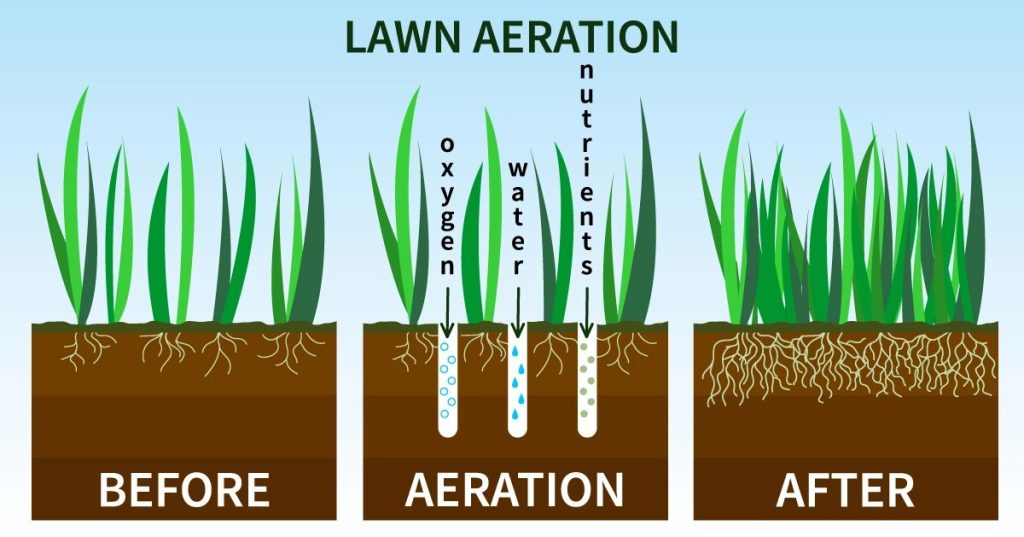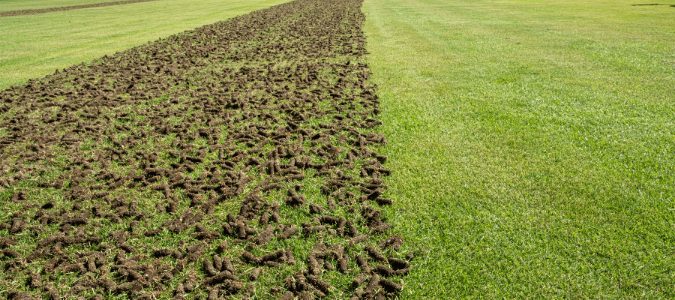lawn aeration
Unlock the secret to a lush, green yard with our comprehensive guide on lawn aeration. Dive deep into techniques, benefits, and best practices to ensure your grass thrives all year round.

Lawns are the crowning glory of many homes, and to keep them lush and green, aeration is key. Just like a marathon runner needs deep breaths to perform, your lawn needs aeration to flourish. Let’s dive into the basics.
TABLE OF CONTENT
What is Lawn Aeration?
Lawn aeration is a simple yet transformative process where small holes are made in the soil to allow air, water, and nutrients to penetrate the grass roots. This promotes deep root growth, strengthening and energizing the turf. Think of it as giving your lawn a spa day where it gets to breathe deeply and rejuvenate.

Why Should I Aerate My Lawn?
If you’re looking for a superstar lawn that’s the envy of your neighborhood, aeration is your ticket. Over time, soil gets compacted, stifling the roots and preventing them from accessing essential nutrients. Without aeration, you’re essentially choking your lawn. It’s like trying to drink a thick smoothie through a narrow straw—frustrating and unsatisfying!
What are the Benefits of Lawn Aeration?
Oh boy, where do we start? Aeration is like a magic potion for your lawn. Firstly, it promotes root growth by giving them room to breathe and expand. This means your grass becomes more resilient and can better handle drought conditions. Secondly, it improves water absorption, so no more puddles after a downpour. Last but not least, aeration helps in breaking down thatch—a thick layer of roots, stems, and debris that can accumulate on the lawn’s surface.
When Should I Aerate My Lawn?
Timing is everything, especially with lawn aeration. The best times to aerate are during the growing seasons when the grass can heal and fill in any open areas after soil plugs are removed. Typically, this means aerating in early spring or early fall for most grass types. Think of it as aligning your lawn’s “rejuvenation time” with nature’s cycle.
How Often Should I Aerate My Lawn?
How often you aerate depends on the type of soil and grass you have. For lawns with clay soil, aeration should be an annual event. If you’ve got sandy soil, every two years should do the trick. Just remember, it’s not a “one size fits all” scenario. Keep an eye on your lawn; if it looks stressed or water is pooling on the surface, it might be time to aerate.

How to Aerate My Lawn?
Ready to dive in? Mow your lawn a little shorter than normal to start. Next, water the lawn a day before to soften the soil. Using an aerator, make passes over your lawn to punch holes, ensuring you cover each area only once. Once done, leave the soil plugs on the lawn; they’ll break down and help improve the soil’s texture. Voila! Your lawn’s now got room to breathe.
Cost to Aerate My Lawn?
Hiring a professional can cost anywhere from $50 to $200, depending on your lawn’s size. DIY enthusiasts can rent an aerator for around $50 to $80 per day. Weigh the pros and cons—sometimes, letting a pro handle it can save you both time and potential backaches!
DIY Lawn Aeration
Going the DIY route? You brave soul! First, rent or buy a manual or mechanical aerator. Make sure you understand how to use it securely. Follow the steps mentioned earlier and remember, patience is key. It’s a workout, but think of the rewards—a beautiful, lush lawn!
Best Lawn Aerator
There are various aerators out there, from spike aerators to plug (core) aerators. For most homeowners, a plug aerator is the best choice as it removes a core of grass and soil rather than just poking holes. Brands like Yard Butler and Agri-Fab often come highly recommended.

Lawn Aeration Tips
- Water your lawn a day before for easier soil penetration.
- Don’t aerate during dry, drought conditions.
- Mark sprinkler heads to avoid damaging them.
- When the soil is moist, but not wet, aerate it.
- Leave the soil cores; they’ll decompose and benefit your lawn.
Lawn Aeration Mistakes to Avoid
- Avoid aerating newly seeded or sodded areas for a year.
- Don’t aerate during the lawn’s dormant season.
- Ensure the soil is the right moisture level—not too dry or too wet.
- Not overlapping passes can lead to uneven aeration.
Lawn Aeration Grass Types
Different grass types have distinct aeration needs. For instance, warm-season grasses prefer late spring to early summer aeration, while cool-season grasses thrive when aerated in the fall. Knowing your grass type can make a world of difference in achieving that lush lawn dream.
How to Aerate My Lawn with a Core Aerator
Core aerators are the MVPs of lawn aeration. These tools remove small cores of soil and thatch, allowing for deeper penetration. To use one, start by watering your lawn to moisten the soil. Run the core aerator over your lawn, ensuring you cover all areas. Remember to leave the extracted soil cores; they’ll naturally decompose.

How to Aerate My Lawn Without a Core Aerator
No core aerator? No worries! Spike aerators or even a garden fork can do the trick. Push the spikes or fork into the soil about 2-3 inches apart and 2 inches deep. It’s a bit more manual but can be just as effective for smaller lawns.
When to Aerate My Lawn in Spring
Spring is a time of rebirth and growth. For cool-season grasses, aerate in the early spring, just as the grass starts growing. This ensures the grass recovers quickly and utilizes the increased airflow and nutrients effectively.
When to Aerate My Lawn in Fall
Fall aeration is ideal, especially before any overseeding. For cool-season grasses, aim for early fall, ensuring you give the lawn ample time to recover before winter sets in.
How to Aerate My Lawn After Overseeding
Overseeding rejuvenates tired lawns. If you’ve overseeded, wait 4-6 weeks to aerate. This gives the new seeds time to establish. Post-aeration, you can enjoy a thicker, healthier lawn.

Best Time to Aerate My Lawn in Texas
In Texas, where warm-season grasses dominate, late spring is your best bet. Aim for a time when the grass is in its peak growth phase, ensuring it bounces back quickly post-aeration.
Best Lawn Aerator for Compacted Soil
For seriously compacted soil, a plug or core aerator is your best friend. These tools pull up plugs of soil, effectively breaking up compaction and allowing for better water, nutrient, and air penetration.
How to Aerate My Lawn on a Hill
Aerating slopes can be tricky. For safety, use a manual spike aerator or garden fork. Start at the base of the hill and work your way up in a zigzag pattern. This ensures even coverage without the risk of machinery rolling downhill.
How to Aerate My Lawn with Pets
Pets and lawns go hand in hand. If you have furry friends, ensure they’re safely indoors during aeration. Post-aeration, give the soil plugs a day or two to break down before letting your pets out. This prevents them from munching on the soil cores.

How to Aerate My Lawn with Crabgrass
Crabgrass can be a menace. If you’re dealing with this weed, aerate during its dormant phase to prevent spreading. Post-aeration, consider applying a pre-emergent herbicide to curb its growth.
How to Aerate My Lawn After a Drought
Post-drought lawns are stressed. Give your grass some time to recover before aerating. Once the lawn is green and growing, aerate to improve water and nutrient absorption.
Lawn Aeration for Bermuda Grass
Bermuda grass loves the sun and thrives in warm climates. For this tough grass, the ideal aeration period is late spring to early summer. By aerating during its peak growth season, you ensure quick recovery and a dense, green turf by summertime.
Lawn Aeration for St. Augustine Grass
St. Augustine grass, with its broad flat blades, is a favorite in many coastal areas. Late spring, when the grass is actively growing but before the heat peaks, is the perfect time to aerate. This ensures the grass has ample time to fill in any open spaces before potential summer stresses.

Lawn Aeration for Zoysia Grass
Zoysia, known for its tolerance to shade and traffic, benefits greatly from aeration in early summer. This timing ensures the grass is actively growing and can quickly utilize the benefits of aeration.
Lawn Aeration for Kentucky Bluegrass
A cool-season grass, Kentucky Bluegrass thrives when aerated in early fall or spring. Aeration during these periods ensures the grass gets a boost in root growth and prepares it for the coming seasons.
Lawn Aeration for Ryegrass
Ryegrass, with its fine texture and rapid growth rate, prefers aeration in the early fall. This timing aligns with its natural growth spurt, ensuring a lush, green lawn through the cooler months.
Lawn Aeration for Fescue
Fescue grasses, known for their drought tolerance, benefit from aeration in the early fall. This helps the grass strengthen its root system and absorb essential nutrients, prepping it for winter.

Lawn Aeration for Centipedegrass
Centipedegrass, a low-maintenance grass, thrives in acidic soils. Aerate this grass type in late spring to early summer, ensuring it’s at its peak growth phase and can recover quickly.
Lawn Aeration for Buffalo Grass
Buffalo grass, a native to North American prairies, is drought-resistant and thrives in tough conditions. Aerate in late spring, ensuring the grass is actively growing and can benefit from increased airflow and nutrients.
Lawn Aeration for Bahia Grass
Bahia grass, often used in pastures, is tough and pest-resistant. Aerate in late spring to early summer, aligning with its natural growth phase for best results.
Lawn Aeration for Bentgrass
Bentgrass, commonly used on golf courses, has a fine texture and loves cool climates. Aerate in the early spring or fall, ensuring the grass can recover and thrive in the subsequent months.

Lawn Aeration for Dichondra
Dichondra, often used as a ground cover, benefits from aeration in the spring. This ensures it has ample time to fill in and establish a dense carpet-like appearance.
Lawn Aeration for Microclover
Microclover, a beneficial addition to lawns for its nitrogen-fixing properties, should be aerated in the spring. This ensures it can spread and establish itself, enriching the soil in the process.
Conclusion
Aerating your lawn, whether it’s lush Bermuda, resilient St. Augustine, shade-loving Zoysia, or the cool-season favorite Kentucky Bluegrass, is an essential step to ensuring its health and vibrancy. From understanding the core essence of lawn aeration to discerning the perfect timing—be it spring’s fresh bloom or fall’s gentle coolness—every blade of grass, from the dense Ryegrass patches to the sprawling Fescue fields, benefits from this process. Whether you’re tending to the delicate Centipedegrass, the robust Buffalo grass, the pasture-friendly Bahia, or even the golfer’s choice Bentgrass, aeration is key. And let’s not forget our ground cover champions, Dichondra and Microclover, which equally thrive with timely aeration.
The methods might vary—you could go the DIY route, choose between core and spike aerators, or even consider the lay of the land, especially if you’re on a hill. Regardless, knowing potential pitfalls, like dealing with crabgrass or post-drought conditions, and understanding the unique needs of various grass types, from the sun-loving Bermuda to the cool and composed Ryegrass, can make all the difference.
In the vast world of lawn care, from Texas’s vast plains to coastal lawns, one thing remains constant—the undeniable benefits of aeration. So whether you’re looking for the best tools, aiming for a post-overseeding aeration, or simply seeking tips and tricks, remember: a well-aerated lawn is the foundation of a green, lush, envy-worthy yard. Happy aerating!
